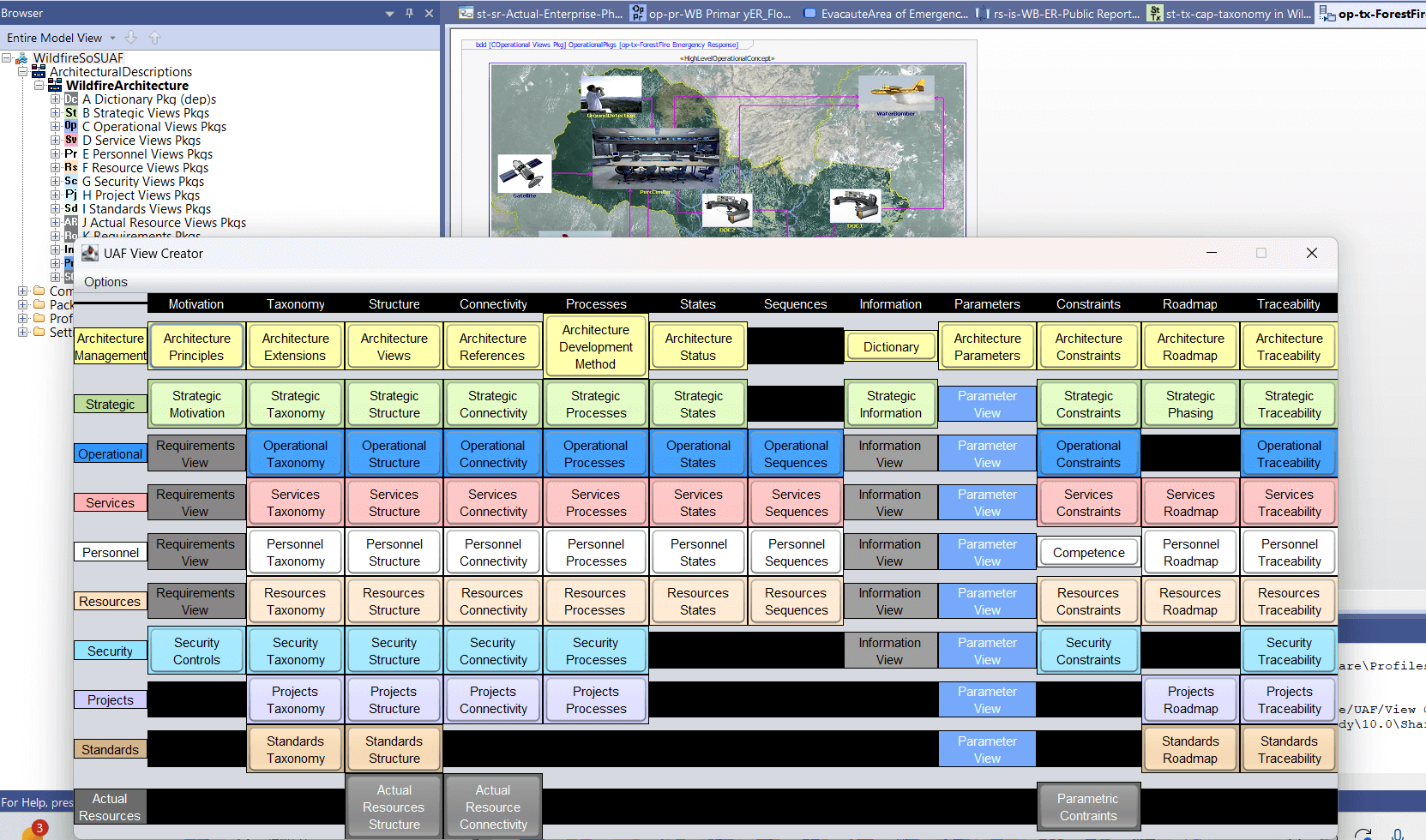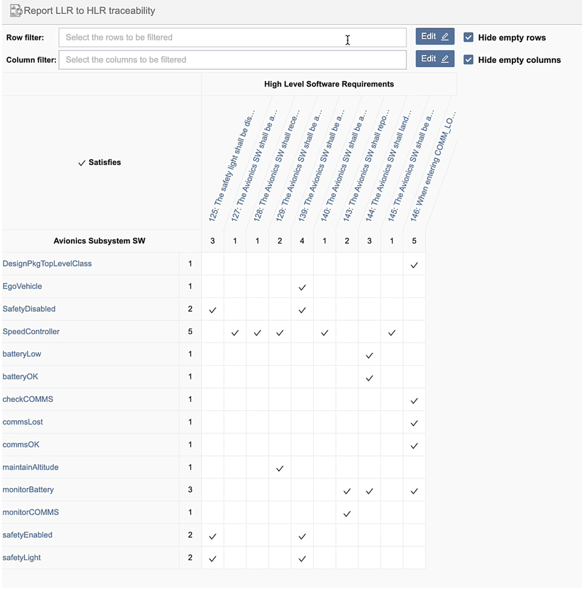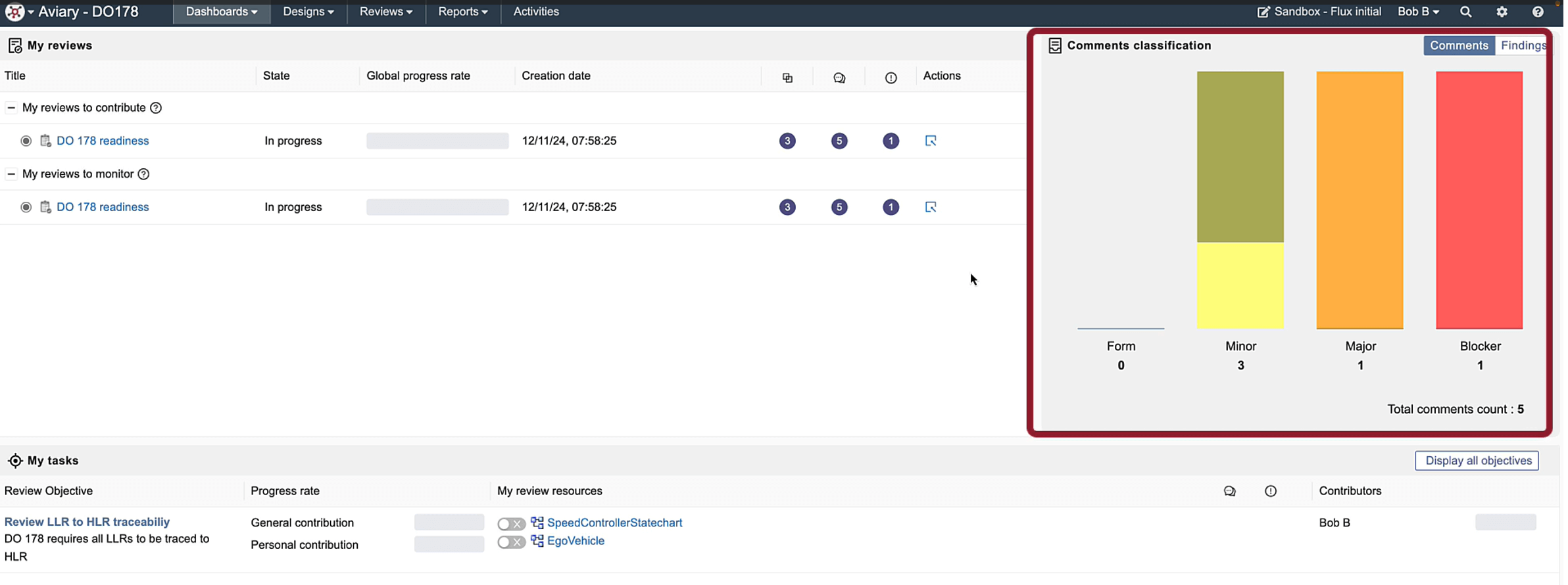Model-Based Systems Engineering (MBSE) is the cornerstone of a fully digital engineering ecosystem. Organizations such as INCOSE and the Department of Defense (DoD) champion this approach in their digital engineering strategies, and MBSE is transforming how complex systems are designed, analyzed, and managed. However, as organizations embark on their MBSE journey, one aspect often determines the success of their initiative: the choice of the right systems modeling tool. Indeed, the true value of modeling tools resides in their ability to drive a paradigm shift in systems development. So, to help you make the best decision for your projects, we've written an article that addresses the key features and capabilities you need to look for in a systems modeling tool.
TABLE OF CONTENTS
The Strategic Role of Systems Modeling Tools
Foundational MBSE tools capabilities
The Importance of Interoperability Support
Integrating AI into MBSE Tools
The Strategic Role of Systems Modeling Tools
Systems modeling tools serve both individual system engineers and entire engineering organizations.
For engineers, a modeling tool provides a productive environment to create, analyze, and review system models. At the organizational level, the tool enables model sharing and collaboration across teams, promotes reuse, and supports the dissemination of standardized modeling practices and methodologies.
At both levels, a systems modeling tool should function as an integral part of the digital engineering fabric and interoperate effectively with the entire engineering toolchain.
Important NoteThe various considerations outlined in this article may carry different weights depending on the nature of the organization: large vs. small organizations, integrators vs. suppliers, the maturity level of the organization, etc. Please also note that there may be other selection factors, certainly just as important to consider, that I have not mentioned in this article. |
What are the Foundational Capabilities of Systems Modeling Tools?
In the following sections, I'll share the core capabilities every systems modeling tool should provide. It includes:
- Adequate support for the modeling language
- Usability and User Experience
- Model validation and simulation
- Model versioning and configuration management
- Tool customization
Adequate Support for the Modeling Language
MBSE relies on formal modeling languages, the most common of which is SysML. SysML[1] includes a concrete graphical syntax – realized through graphical diagrams – and an abstract syntax, typically visualized in the model browser. The tool must support both the graphical notation and the structure defined by the abstract syntax.
Another important capability is the ability to detect and flag invalid model structures, assisting the modeler in creating well-formed models effectively.
In addition, the tool should be able to generate graphical representations from the abstract syntax structures. Proper compliance with the language standard is important to share practices, facilitate learning, and enable interoperability across organizations and tools.
[1] In this article, we refer to SysML V1.x. While most of the content is also relevant for the recently standardized SysML v2, certain aspects of SysML v2, such as its standard API and textual syntax, may affect some of the considerations discussed here.
Usability and User Experience Capabilities
User Experience is a major factor in successful MBSE deployment, given the intrinsic complexity of systems modeling tools.
Important usability capabilities include “model search & replace”, query filtering, ergonomic model creation and editing, model navigation, copying, moving, and more. All these capabilities should work in both diagram and model browser contexts.
Another important aspect of usability is its support for tabular views such as tables and matrices, which simplify data visualization and model analysis.
Finally, consistency across model elements editing and diagrams that directly impact the learning curve is another factor that must be considered.
Model Validation and Simulation
A key capability of modeling tools also includes model validation through execution, along with complementary features such as model-based testing (MBT) and parametric analysis. This is an area of significant functional differences across tools, but it is particularly decisive when it comes to choosing the right tool.
For instance, IBM Rhapsody provides all of the above capabilities: Model simulation, MBT module ("Rhapsody Test Conductor"), and a parametric analysis capability relying on integrations with mathematical solvers like Simulink or Open-source Maxima.
Model simulation typically imposes a usability challenge for tools. How easy it is to “debug” simulation problems, track the simulation across the various model views, and assess whether the model behaves according to the expectations.
Model Versioning and Configuration Management
Any production engineering environment requires a strong configuration management system.
In an MBSE context, model configuration management ensures consistent collaboration on model artifacts across multiple engineers. It maintains historical baselines and orchestrates overall change management practices. It would also typically support branching mechanisms that are important for parallel agile workflows, and also for variant management practices.
One of the main challenges in model configuration management is performing compare and merge, due to the non-textual nature of models and the complex relationships across their artifacts. A usable model-based "compare-and-merge" capability is then essential for seamless MBSE team collaboration.
Tools such as IBM Rhapsody Model Manager and Rhapsody diff-merge exemplify such capabilities.
Tool Customization
Tool customization is also critical for MBSE deployment. It supports the implementation of common practices (IBM Harmony, OOSEM, etc.), domain-specific language extensions, and integrations with other engineering tools. A core component of customization is the tool’s API that should provide full access to the model repository and support standard CRUD (Create, Read, Update, Delete) operations.
The API should also provide extension points that enable developers to tailor the user interface with custom menus, toolbars, and helpers, as well as triggers to complement tool operations when opening and closing models.
Another important aspect also involves data-driven customization. It allows organizations to define default graphical properties, custom shapes, and bitmaps, aligning with their DSLs (Domain Specific modeling) and organizational modeling conventions. Implementing language extensions using UML profiles can further enrich the basic usage of stereotypes, such as controlling menus, diagram bars, first-class custom keywords, and more. For instance, IBM Rhapsody provides a fully featured Java API and a wide set of property settings to control all tool preferences.
Significant customizations like realizing complete DSLs, can be complicated and require deep expertise. Solutions like the Profile Builder for IBM Rhapsody automate customization and hide this complexity for common customization tasks like custom DSLs.

Fig. 1 - DSL customization in IBM Rhapsody - UAF Modeling
The Importance of Interoperability Support
Interoperability enables meaningful integration between heterogenous and disconnected lifecycle tools to participate in digital threads and cross-discipline workflows. Rather than remaining siloed, system models become collaborative assets that support traceability, reuse, and alignment across the lifecycle. This includes interactions:
- "upstream" with requirements tools,
- "downstream" with discipline design tools for software, electronics, and mechanical,
- "sideways" with other specialty modeling tools or applications, like change and issue management.
➡️ Interoperability is central to achieving end-to-end traceability and ensuring that data seamlessly flows across the whole engineering process following the Digital Thread.
In the following sections, we explore several core aspects of interoperability support:
- Model Transformation
- Cross-tool linking (traceability)
- Publication, review, and reporting
- Model interchange
Model Transformation
The Digital Thread, a continuous flow of data throughout the system lifecycle, is an integral part of modern MBSE. At the heart of generating such a digital handoff lies model transformation.
This technology maps the MBSE model (typically the logical design) into architectural descriptions based on specific implementation technologies. Model transformation is crucial for this process, as it allows, for example, domain experts to specify the mapping from a logical system model into a software component architecture. Another use case is transforming MBSE logical or physical specifications into PLM BOMs or to electrical models in an E/E design tool.
For instance, SodiusWillert's Model-to-Model for IBM Rhapsody is a model transformation framework that allows table-driven mappings of system components into implementation components.
Cross-tool linking (traceability)
Implementing cross-tool traceability is an essential capability for realizing digital threads. A common use case is establishing traceability between system model elements in an MBSE tool and requirements managed in a requirements management tool.
Another frequent example involves linking model elements with issue management tools like Atlassian Jira.
There are several techniques for implementing cross-tool linking:
→ Copy and link
This traditional “copy” technique replicates elements from one tool into another and then creates traceability links within that tool. This approach is often used with SysML requirements, which typically originate in a requirements management tool and are replicated in the MBSE tool as SysML Requirements.
However, this approach has two major drawbacks:
- Limited visibility – the traceability links are only visible in one tool (e.g., the MBSE tool).
- Keeping the copies in sync – The duplicated elements need to maintain continuous synchronization of the overlapped elements to remain consistent across tools.
→ Linked data approach with OSLC
The Open Services for Lifecycle Collaboration (OSLC) standard plays a key role in enabling federated linking between engineering tools, relying on the W3C linked data approach. This approach:
- utilizes HTTP URLs to represent links to lifecycle elements
- leverages the HTTP/Rest protocol to allow tools to inquire
- and establish links across tools through standard services for discovery, creation, preview, and more.
What makes OSLC unique is that it avoids data replication while providing bidirectional linking and mutual visibility of links across tools. Its standard services also eliminate the need for tool-specific integrations. Once a tool is OSLC-enabled, it can connect and seamlessly link with any other OSLC-enabled tool.
SodiusWillert OSLC Connectors provides OSLC service adapters for widely used tools such as Atlassian Jira and PTC Windchill, enabling MBSE tools like IBM Rhapsody and Dassault CatiaMagic (Cameo) to link with Jira and Windchill.
Supported OSLC services are a major advantage for interoperability when considering an MBSE tool.
→ Link management tools
Link management tools maintain links across client tools within a centralized link repository. They index model elements and other engineering artifacts so that relationships can be created, managed, and visualized within the link management environment.
Link management is often one major capability of digital thread management solutions, such as SodiusWillert SECollab. SECollab enables linking across a myriad of MBSE tools and other engineering tools. It provides visualization and link analysis throughout the entire lifecycle to support full lifecycle traceability.
SECollab also offers additional services, as I will describe in the following sections.

Fig 2. Cross-tool traceability management with SodiusWillert SECollab
Publication, review, and reporting
Certain cross-lifecycle activities require a centralized indexer of engineering data to support cross-domain activities such as design reviews and central reporting. These activities typically span multiple tools and cannot be localized to a single engineering environment.
SodiusWillert SECollab serves as such an indexer, allowing organizations to perform cross-domain reviews and centralized reporting across different modeling and other engineering tools.
→ Model Review and Markup
Model review and markup is an important collaborative capability that enables various stakeholders to access and evaluate models by attaching review findings and visual annotations (markups) to diagrams. This capability replaces document-based reviews with an online, model-centric review process.
SodiusWillert SECollab allows publishing content from a wide range of modeling and engineering tools, including IBM DOORS, Dassault CatiaMagic (Cameo), IBM Rhapsody, and SparxEA. It also orchestrates the review process by designating reviewers, managing review cycles, and tracking the overall review progress.

Fig. 3. Model Review Dashboard in SECollab
→ Central Reporting
Central reporting enables data analysis across multiple tools and the presentation of that data in report dashboards. For example, it allows the creation of a requirements coverage matrix spanning an MBSE tool like Cameo and IBM DOORS, or the visualization of progress and review activities across a set of designs.
Model Interchange
It is often necessary to interchange MBSE designs across MBSE tools in the context of the digital thread.
There are several use cases for such a capability:
- System-to-Software – An organization uses one MBSE tool for Systems Engineering and another for Software Design, with the latter offering extended software flow capability (e.g., IBM Rhapsody).
- Cross-organization exchange – One organization, let’s say the integrator, is standardized on different tools, and another, the supplier, is standardized on different tools.
Currently, MBSE standardization is not sufficient to enable such cross-tool interchange without a significant loss of information. One solution is the SodiusWillert Publisher, a family of plug-ins that enables precise model exchange across leading MBSE tools, including Dassault Catia Magic, IBM Rhapsody, and Sparx EA, without any loss of data.
As MBSE practices mature, AI integration is also emerging as a powerful enabler that complements interoperability by providing adaptive support throughout the modeling process. It contributes to the automation of routine tasks, the improvement of model quality, and the reduction of the learning curve for engineers.
We will look at this in detail in the following section.
Integrating AI into MBSE Tools
One of the key challenges in MBSE adoption is the complexity and steep learning curve of both the tools and the modeling language. It typically takes about three months for an individual to become proficient with an MBSE tool, and for many, this hinders MBSE adoption. The good news is that Artificial Intelligence, and more specifically, Large Language Models (LLMs), can significantly mitigate these challenges and accelerate MBSE adoption. With the maturation of AI technology and the introduction of MCP (Model Control Protocol), AI systems can now directly interact with and operate modeling tools, effectively acting as engineering co-designers.
When properly integrated through the tool MCP servers, AI is able to assist users with many of the common challenges associated with MBSE tools. A dedicated MBSE tool MCP agent, such as SodiusWillert AI modeling assistant for IBM Rhapsody, is necessary to achieve this full potential.
Here are some key use cases for such an AI-based modeling assistant:
- Model Creation from high-level requirements: Creating a complete model includes several modeling aspects such as detailed requirements, architectural design, behaviors (e.g., state machines), and even a user interface prototype to drive the model execution. Model creation also includes developing graphical diagrams within the tool.
- Model analysis and correction: The assistant can review the model, generate summaries, identify incomplete elements, and address issues such as missing descriptions, broken traceability links to requirements, and many more inconsistencies.
- Applying MBSE methodology and templates based on reference models: Part of the assistant kit includes a set of reference models that guide the AI to follow specific modeling guidelines and methodologies. For example, the assistant can apply the Harmony[2] methodology and related guidelines when analyzing and creating models.
- Applying and leveraging domain-specific profiles: The assistant can read and learn domain-specific profiles, either custom or industry standards, such as RAAML, UAF, and assist in generating models based on such profiles.
- A tool and language “co-pilot”: The AI assistant can also act as a co-pilot, helping users to complete incremental modeling tasks, like “how to create a requirements table”, or “create an interface block”, etc. For less experienced engineers, such assistance may have a significant productivity impact.
It is important to note that the effectiveness of MBSE tool-AI integration heavily depends on the quality of the provided agent. Indeed, the ability of the AI to successfully accomplish a wide range of modeling tasks varies a lot based on the agent’s sophistication and the depth of guidance embedded within it.
At SodiusWillert, we have witnessed remarkable results as our modeling assistant has evolved and matured.
➡️ Read our experts' interview on the role of AI in Systems Engineering, especially within the context of MBSE.
[2] Full coverage of Harmony by the SodiusWillert AI assistant is still a work in progress
Summary
Selecting the right MBSE tool goes beyond just evaluating its core, traditional capabilities, such as modeling language support, model management, and usability features. The real differentiators in today's digital engineering landscape are often the ones that get overlooked and are not yet widely adopted: interoperability and AI integration. These advanced capabilities bridge the gap between traditional modeling and the connected, intelligent engineering ecosystems of tomorrow.
And I will conclude by saying that ensuring your MBSE tool supports these capabilities is not just forward thinking; it's an essential step toward thriving in the AI-driven era of systems engineering.





Leave us your comment